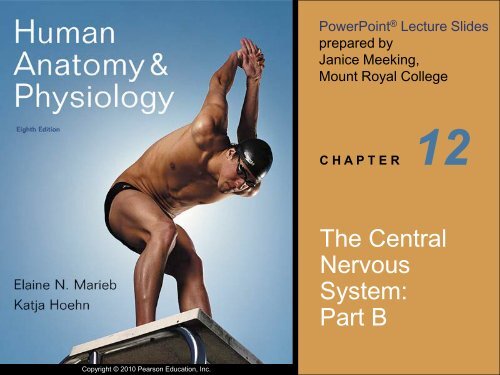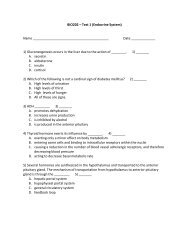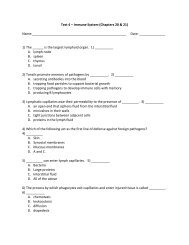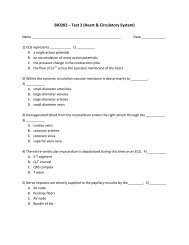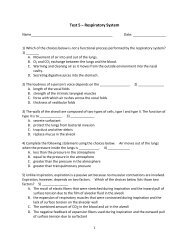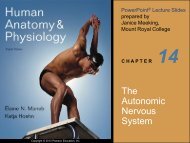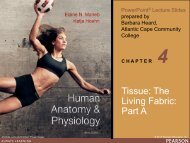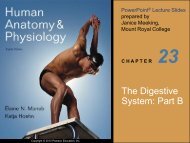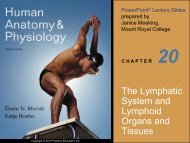Chapter 12b - Next2Eden
Chapter 12b - Next2Eden
Chapter 12b - Next2Eden
You also want an ePaper? Increase the reach of your titles
YUMPU automatically turns print PDFs into web optimized ePapers that Google loves.
PowerPoint ® Lecture Slides<br />
prepared by<br />
Janice Meeking,<br />
Mount Royal College<br />
C H A P T E R<br />
12<br />
The Central<br />
Nervous<br />
System:<br />
Part B<br />
Copyright © 2010 Pearson Education, Inc.
Lateralization of Cortical Function<br />
• Lateralization<br />
• Division of labor between hemispheres<br />
• Cerebral dominance<br />
• Designates the hemisphere dominant for<br />
language (left hemisphere in 90% of<br />
people)<br />
Copyright © 2010 Pearson Education, Inc.
Lateralization of Cortical Function<br />
• Left hemisphere<br />
• Controls language, math, and logic<br />
• Right hemisphere<br />
• Insight, visual-spatial skills, intuition, and<br />
artistic skills<br />
• Left and right hemispheres communicate via<br />
fiber tracts in the cerebral white matter<br />
Copyright © 2010 Pearson Education, Inc.
Diencephalon<br />
• Three paired structures<br />
• Thalamus<br />
• Hypothalamus<br />
• Epithalamus<br />
• Encloses the third ventricle<br />
PLAY<br />
Animation: Rotatable brain (sectioned)<br />
Copyright © 2010 Pearson Education, Inc.
Cerebral hemisphere<br />
Septum pellucidum<br />
Interthalamic<br />
adhesion<br />
(intermediate<br />
mass of<br />
thalamus)<br />
Interventricular<br />
foramen<br />
Anterior<br />
commissure<br />
Hypothalamus<br />
Optic chiasma<br />
Pituitary gland<br />
Mammillary body<br />
Pons<br />
Medulla oblongata<br />
Spinal cord<br />
Corpus callosum<br />
Fornix<br />
Choroid plexus<br />
Thalamus<br />
(encloses third<br />
ventricle)<br />
Posterior commissure<br />
Pineal gland<br />
(part of epithalamus)<br />
Corpora<br />
quadrigemina Mid-<br />
Cerebral brain<br />
aqueduct<br />
Arbor vitae (of<br />
cerebellum)<br />
Fourth ventricle<br />
Choroid plexus<br />
Cerebellum<br />
Copyright © 2010 Pearson Education, Inc. Figure 12.12
Thalamus<br />
• 80% of diencephalon<br />
• Superolateral walls of the third ventricle<br />
• Connected by the interthalamic adhesion<br />
(intermediate mass)<br />
• Contains several nuclei, named for their<br />
location<br />
• Nuclei project and receive fibers from the<br />
cerebral cortex<br />
Copyright © 2010 Pearson Education, Inc.
Thalamic Function<br />
• Gateway to the cerebral cortex<br />
• Sorts, edits, and relays information<br />
• Afferent impulses from all senses and all parts of<br />
the body<br />
• Impulses from the hypothalamus for regulation of<br />
emotion and visceral function<br />
• Impulses from the cerebellum and basal nuclei to<br />
help direct the motor cortices<br />
• Mediates sensation, motor activities, cortical<br />
arousal, learning, and memory<br />
Copyright © 2010 Pearson Education, Inc.
Hypothalamus<br />
• Forms the inferolateral walls of the third<br />
ventricle<br />
• Contains many nuclei<br />
• Example: mammillary bodies<br />
• Paired anterior nuclei<br />
• Olfactory relay stations<br />
• Infundibulum—stalk that connects to the<br />
pituitary gland<br />
Copyright © 2010 Pearson Education, Inc.
Paraventricular<br />
nucleus<br />
Anterior<br />
commissure<br />
Fornix<br />
Preoptic<br />
nucleus<br />
Anterior<br />
hypothalamic<br />
nucleus<br />
Supraoptic<br />
nucleus<br />
Suprachiasmatic<br />
nucleus<br />
Arcuate<br />
Optic<br />
nucleus<br />
chiasma<br />
Pituitary<br />
Infundibulum<br />
gland<br />
(stalk of the<br />
pituitary gland)<br />
(b) The main hypothalamic nuclei.<br />
Dorsomedial<br />
nucleus<br />
Posterior<br />
hypothalamic<br />
nucleus<br />
Lateral<br />
hypothalamic<br />
area<br />
Ventromedial<br />
nucleus<br />
Mammillary<br />
body<br />
Copyright © 2010 Pearson Education, Inc. Figure 12.13b
Hypothalamic Function<br />
• Autonomic control center for many<br />
visceral functions (e.g., blood pressure,<br />
rate and force of heartbeat, digestive tract<br />
motility)<br />
• Center for emotional response: Involved<br />
in perception of pleasure, fear, and rage<br />
and in biological rhythms and drives<br />
Copyright © 2010 Pearson Education, Inc.
Hypothalamic Function<br />
• Regulates body temperature, food intake,<br />
water balance, and thirst<br />
• Regulates sleep and the sleep cycle<br />
• Controls release of hormones by the<br />
anterior pituitary<br />
• Produces posterior pituitary hormones<br />
Copyright © 2010 Pearson Education, Inc.
Epithalamus<br />
• Most dorsal portion of the diencephalon;<br />
forms roof of the third ventricle<br />
• Pineal gland—extends from the posterior<br />
border and secretes melatonin<br />
• Melatonin—helps regulate sleep-wake<br />
cycles<br />
Copyright © 2010 Pearson Education, Inc.
Cerebral hemisphere<br />
Septum pellucidum<br />
Interthalamic<br />
adhesion<br />
(intermediate<br />
mass of<br />
thalamus)<br />
Interventricular<br />
foramen<br />
Anterior<br />
commissure<br />
Hypothalamus<br />
Optic chiasma<br />
Pituitary gland<br />
Mammillary body<br />
Pons<br />
Medulla oblongata<br />
Spinal cord<br />
Corpus callosum<br />
Fornix<br />
Choroid plexus<br />
Thalamus<br />
(encloses third<br />
ventricle)<br />
Posterior commissure<br />
Pineal gland<br />
(part of epithalamus)<br />
Corpora<br />
quadrigemina Mid-<br />
Cerebral brain<br />
aqueduct<br />
Arbor vitae (of<br />
cerebellum)<br />
Fourth ventricle<br />
Choroid plexus<br />
Cerebellum<br />
Copyright © 2010 Pearson Education, Inc. Figure 12.12
Brain Stem<br />
• Three regions<br />
• Midbrain<br />
• Pons<br />
• Medulla oblongata<br />
Copyright © 2010 Pearson Education, Inc.
Brain Stem<br />
• Similar structure to spinal cord but<br />
contains embedded nuclei<br />
• Controls automatic behaviors necessary<br />
for survival<br />
• Contains fiber tracts connecting higher<br />
and lower neural centers<br />
• Associated with 10 of the 12 pairs of<br />
cranial nerves<br />
Copyright © 2010 Pearson Education, Inc.
Frontal lobe<br />
Olfactory bulb<br />
(synapse point of<br />
cranial nerve I)<br />
Optic chiasma<br />
Optic nerve (II)<br />
Optic tract<br />
Mammillary body<br />
Midbrain<br />
Pons<br />
Temporal lobe<br />
Medulla<br />
oblongata<br />
Cerebellum<br />
Spinal cord<br />
Copyright © 2010 Pearson Education, Inc. Figure 12.14
Diencephalon<br />
• Thalamus<br />
• Hypothalamus<br />
Mammillary body<br />
Oculomotor nerve (III)<br />
Trochlear nerve (IV)<br />
Middle cerebellar<br />
peduncle<br />
Abducens nerve (VI)<br />
Vestibulocochlear<br />
nerve (VIII)<br />
Pyramid<br />
Ventral root of first<br />
cervical nerve<br />
Decussation of pyramids<br />
Spinal cord<br />
(a) Ventral view<br />
Optic chiasma<br />
Optic nerve (II)<br />
Crus cerebri of<br />
cerebral peduncles<br />
(midbrain)<br />
Trigeminal nerve (V)<br />
Pons<br />
Facial nerve (VII)<br />
Glossopharyngeal nerve (IX)<br />
Hypoglossal nerve (XII)<br />
Vagus nerve (X)<br />
Accessory nerve (XI)<br />
View (a)<br />
Thalamus<br />
Hypothalamus<br />
Midbrain<br />
Pons<br />
Medulla<br />
oblongata<br />
Diencephalon<br />
Brainstem<br />
Copyright © 2010 Pearson Education, Inc. Figure 12.15a
Crus cerebri of<br />
cerebral peduncles<br />
(midbrain)<br />
Infundibulum<br />
Pituitary gland<br />
Thalamus<br />
Superior colliculus<br />
Inferior colliculus<br />
Trochlear nerve (IV)<br />
View (b)<br />
Trigeminal nerve (V)<br />
Pons<br />
Facial nerve (VII)<br />
Abducens nerve (VI)<br />
Glossopharyngeal nerve (IX)<br />
Hypoglossal nerve (XII)<br />
Vagus nerve (X)<br />
Superior cerebellar peduncle<br />
Middle cerebellar peduncle<br />
Inferior cerebellar peduncle<br />
Vestibulocochlear nerve (VIII)<br />
Olive<br />
Thalamus<br />
Hypothalamus<br />
Diencephalon<br />
Accessory nerve (XI)<br />
Midbrain<br />
Pons<br />
Medulla<br />
oblongata<br />
Brainstem<br />
(b) Left lateral view<br />
Copyright © 2010 Pearson Education, Inc. Figure 12.15b
Thalamus<br />
View (c)<br />
Diencephalon<br />
Pineal gland<br />
Anterior wall of<br />
fourth ventricle<br />
Choroid plexus<br />
(fourth ventricle)<br />
Dorsal median sulcus<br />
Dorsal root of<br />
first cervical nerve<br />
(c) Dorsal view<br />
Midbrain<br />
• Superior Corpora<br />
colliculus quadrigemina<br />
• Inferior of tectum<br />
colliculus<br />
• Trochlear nerve (IV)<br />
• Superior cerebellar peduncle<br />
Pons<br />
• Middle cerebellar peduncle<br />
Medulla oblongata<br />
• Inferior cerebellar peduncle<br />
• Facial nerve (VII)<br />
• Vestibulocochlear nerve (VIII)<br />
• Glossopharyngeal nerve (IX)<br />
• Vagus nerve (X)<br />
• Accessory nerve (XI)<br />
Thalamus<br />
Hypothalamus<br />
Midbrain<br />
Pons<br />
Medulla<br />
oblongata<br />
Diencephalon<br />
Brainstem<br />
Copyright © 2010 Pearson Education, Inc. Figure 12.15c
Midbrain<br />
• Located between the diencephalon and the<br />
pons<br />
• Cerebral peduncles<br />
• Contain pyramidal motor tracts<br />
• Cerebral aqueduct<br />
• Channel between third and fourth ventricles<br />
Copyright © 2010 Pearson Education, Inc.
Pons<br />
• Forms part of the anterior wall of the fourth ventricle<br />
• Fibers of the pons<br />
• Connect higher brain centers and the spinal cord<br />
• Relay impulses between the motor cortex and the<br />
cerebellum<br />
• Origin of cranial nerves V (trigeminal), VI (abducens),<br />
and VII (facial)<br />
• Some nuclei of the reticular formation<br />
• Nuclei that help maintain normal rhythm of breathing<br />
Copyright © 2010 Pearson Education, Inc.
Superior cerebellar<br />
peduncle<br />
Trigeminal main<br />
sensory nucleus<br />
Trigeminal<br />
motor nucleus<br />
Middle<br />
cerebellar<br />
peduncle<br />
Trigeminal<br />
nerve (V)<br />
Medial lemniscus<br />
(b) Pons<br />
Fourth<br />
ventricle<br />
Reticular<br />
formation<br />
Pontine<br />
nuclei<br />
Fibers of<br />
pyramidal<br />
tract<br />
Copyright © 2010 Pearson Education, Inc. Figure 12.16b
Medulla Oblongata<br />
• Joins spinal cord at foramen magnum<br />
• Forms part of the ventral wall of the fourth<br />
ventricle<br />
• Contains a choroid plexus of the fourth<br />
ventricle<br />
• Pyramids—two ventral longitudinal ridges<br />
formed by pyramidal tracts<br />
• Decussation of the pyramids—crossover<br />
of the corticospinal tracts<br />
Copyright © 2010 Pearson Education, Inc.
Medulla Oblongata<br />
• Autonomic reflex centers<br />
• Cardiovascular center<br />
• Cardiac center adjusts force and rate of heart<br />
contraction<br />
• Vasomotor center adjusts blood vessel diameter for<br />
blood pressure regulation<br />
• Respiratory centers<br />
• Generate respiratory rhythm<br />
• Control rate and depth of breathing, with pontine<br />
centers<br />
Copyright © 2010 Pearson Education, Inc.
The Cerebellum<br />
• 11% of brain mass<br />
• Dorsal to the pons and medulla<br />
• Subconsciously provides precise timing<br />
and appropriate patterns of skeletal<br />
muscle contraction<br />
Copyright © 2010 Pearson Education, Inc.
Anatomy of the Cerebellum<br />
• Two hemispheres connected by vermis<br />
• Each hemisphere has three lobes<br />
• Anterior, posterior, and flocculonodular<br />
• Folia—transversely oriented gyri<br />
• Arbor vitae—distinctive treelike pattern of<br />
the cerebellar white matter<br />
Copyright © 2010 Pearson Education, Inc.
Anterior lobe<br />
Cerebellar cortex<br />
Arbor<br />
vitae<br />
Cerebellar<br />
peduncles<br />
• Superior<br />
• Middle<br />
• Inferior<br />
Medulla<br />
oblongata<br />
(b)<br />
Flocculonodular<br />
lobe<br />
Posterior<br />
lobe<br />
Choroid<br />
plexus of<br />
fourth<br />
ventricle<br />
Copyright © 2010 Pearson Education, Inc. Figure 12.17b
Cognitive Function of the Cerebellum<br />
• Recognizes and predicts sequences of<br />
events during complex movements<br />
• Plays a role in nonmotor functions such as<br />
word association and puzzle solving<br />
Copyright © 2010 Pearson Education, Inc.


